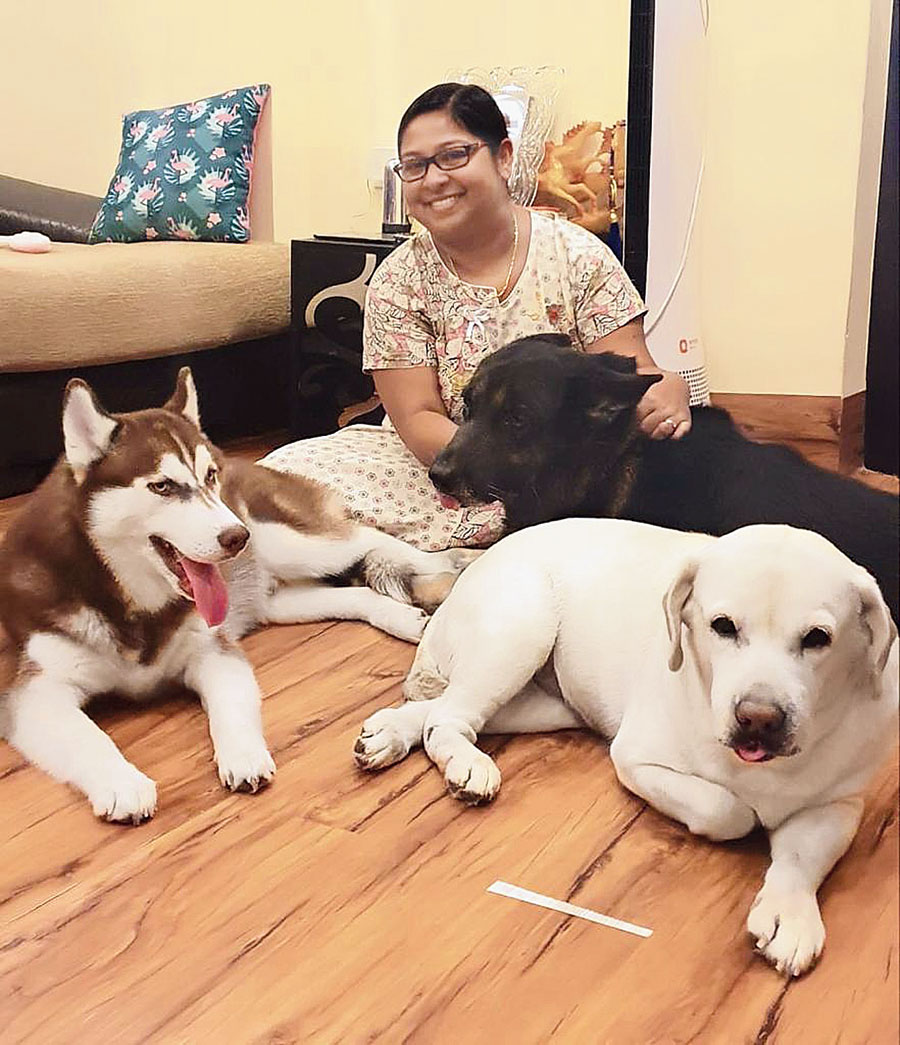The lockdown is not even a week old but among the first to show signs of restlessness and anxiety are pets.
Deprived of their daily walks, dogs — especially larger ones — are getting irritable or showing signs of aggression. Non-stop barking and constant whining are some of the common signs, pet parents said.
Vets and trainers said inadequate exercise can make medium and large dogs prone to anxiety issues, obesity and related ailments.
Tania Mukherjee, a schoolteacher from Santoshpur Survey Park, used to take her five-year-old golden retriever, Jiffy, for a walk twice a day — at 6am and at 5.30pm. That has stopped now.

Saptadeep Pal walks a dog on a treadmill
“Jiffy is toilet trained. He uses the home toilet now. But he is becoming restless indoors. He makes it clear that he wants to go out,” said Tania, who is trying out some “mind-stimulating indoor games” to keep the pet busy, like keeping his preferred food hidden in multiple corners of the house. “Jiffy has to sniff the food and fetch it.”
Rajat Subhro Ray, an advertising professional in Bansdroni, lives with his mother and a four-year-old Labrador, Milo. “We live in a 800sq feet flat. Forget walking, it is becoming tough for Milo to engage in any physical activity. He is constantly barking from the balcony,” said Ray, in his 40s.
Paromita Chatterjee, 34, is worried for Chini, a nine-year-old Labrador, Sheru, a 10-year-old German Shepherd, and Pogo, a five-month-old Siberian husky. “They used to go for a walk in the morning and evening,” said Chatterjee, who lives off Diamond Harbour Road near Behala No. 14 bus stand. “But now they are roaming around as much as they can inside the house. We have a terrace and a large balcony. But nothing compares to outdoor walks.”
Goutam Mukherjee, a vet based in the Deshapriya Park-Lansdowne area, said smaller breeds such as pugs and dachshunds can make up for outdoor walks with indoor games such as fetching a ball or a chewing bone.

The Telegraph
“But bigger dogs ideally need two rounds of walks for workout. It is tough for them to stay indoors continuously. They can become restless, aggressive and show other signs of anxiety. Without proper workout, there is also the threat of obesity and related ailments,” he said.
Saptadeep Pal, dog trainer and pet behaviourist, listed the signs of anxiety in medium and large dogs in the absence of sufficient walking. “The dogs get easily irritated, become aggressive and snap at things, become hyper active, bark or whine incessantly, tear clothes and other fabric. The signs will become more apparent as the home confinement gets longer,” he said. “Like humans, increasing weight would make them vulnerable to cardiac and other problems.”
Pal, who lives in Nagerbazar and has clients all over the city, is also the owner of a nine-year-old American Pit Bull Terrier and a nine-month old German Shepherd. “Smaller dogs do not need much outdoor workout because their calorie intake is low. But a full-sized German Shepherd consumes around 1,200 calories a day. It needs to shed a commensurate amount to stay fit,” he said.
Reducing the amount of food and trying some handy indoor exercises could help, said Pal. “Tug of war, for example, is easy to play irrespective of the size of the home. It is very exhaustive and two sessions of five to seven minutes every day can be very helpful. The game is a combination of mental and physical workout,” he said.











